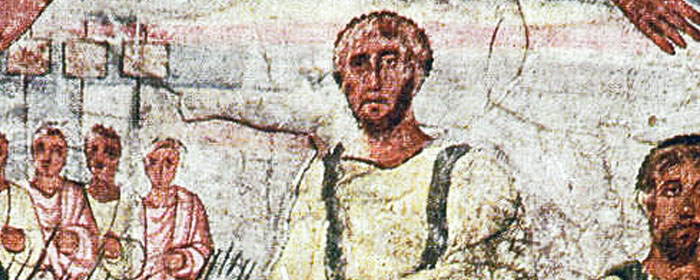What race was Jesus? So far I have considered the look and body of the historical Jesus without using the term ‘race.’ Yet race is an important issue that’s worth discussing here.
In the previous article, I established that the Jesus of history was most probably a sturdy man of color, with short dark hair and beard, and we would recognize him as a person from the ‘Middle East’ if he appeared to us today. He belonged to the ethnic group of Galilean Judeans who lived 2000 years ago in Roman-occupied rural Palestine.

to show the Orientals who’s boss.
However, today, the image of Jesus the Christ, the religious figure, appears to us in all shapes and colors. It has been adapted by and adjusted to countless cultures, and in the process, countless versions of the Christ have been painted, from white to black. I think it is an unavoidable process as people produce something infused with meaning, but since those cultural representations run counter to the historical reality they envelop Jesus in contradictory theological and ideological frameworks. And this is where the issue of ‘race’ becomes significant.
My Problem talking about ‘Race’
In all the previous articles I have avoided the term ‘race.’ To me, it is a problematic term and I never use it in conversations or writing. At the same time, I notice that it is very common in Anglo-Saxon cultures, especially the US, where racism and “race relations” are discussed without end. In Australia, where I live, it is a pressing topic as well.
I realize now that as a native German speaker I have a very different understanding of ‘race’ from English speakers, and I need to address this difference first.
The German word ‘Rasse’ has strong biological and ideological connotations and is forever fused with a shameful history of oppression and genocide. Rasse and a social Darwinist Rassentheorie were the bedrock of Nazi ideology. The public was inculcated with ideas of racial “purity” and “hierarchy.” Differences between so-called races were deemed to be scientifically measurable and signified not only physical and intellectual capability but even the “value” of races. Under Hitler’s bio-policy, Jews were not considered humans.
To be sure, the Nazis didn’t invent this pseudo-science. Racism was abounding in Western academia.
In the 18th century, with the emergence of modern science in Europe, philosophers and naturalists wanted to organize and explain the world. They began to assign people with innate, unchanging traits and to attribute valuations to external differences. This was the intellectual foundation on which colonialism, imperialism, and later national racial ideologies would unfold.
(from “There are no races,” a 2018 report on Germany’s Deutschlandfunk radio)
Even though racism and notions of “race theory” are still common in Germany, this background makes Rasse not just a problematic but dangerous term that easily leads to discrimination.
Does ‘Race’ actually exist?
Let’s be very clear here: When it comes to describing contemporary humans from a biological standpoint, the scientific consensus is that ‘race’ is a misleading term. There exists only one human race on earth. It’s called Homo sapiens.
…[I]t is proven that something like race does not exist: genetically speaking, humans on Earth are almost the same. […] The genetic code does not determine ‘race.’ It is a purely social construct. […] The deciphering of these genes has shown that any two people in the world each differ in one-thousandth of their genome. The differences are therefore very small.[…]
(from “There are no races”)
There are no defined borders: You do not see, ‘here is where a European begins and there is where an Asian ends,’ but there are gradients that reflect the geography.
The answer to “What race was Jesus?” then is simple: he was Homo sapiens, a human. He did not belong to this race or that race—and certainly not to a ‘Jewish race.’ He was simply one of us.
‘Race’ in the English Language
However, in the English-speaking world, and especially the United States, ‘race’ has taken on a meaning beyond genetics. Although generalized physical attributes (skin color, hair, and so on) do accompany it, ‘race’ has also become a word to outline the social realities and cultural identities of different populations.
[In the US,] we have a long history of protests against social inequality and against racism, and here the term race has by now become a category that seeks to describe a very specific dimension of social inequality.
(Liane von Billerbeck, science historian)
In the past, the pseudo-science that led to the Holocaust in Europe supported slavery and segregation in the US, but then ‘race’ and ‘color’ remained in the public discourse. Most educated people understand that ‘race’ is indeed a social construct whose definition is subject to constant change and might be amplified to the convenience of different interest groups. However, that doesn’t seem to take the steam out of the debate since inequalities and racism continue to exist or are even deepened.
The real Question is not about Genes
We can see the identity-political dimension of ‘race’ in the US in this clip from CNN’s Belief Blog (2013):
This discussion reveals the real problem at hand: the question is not “What color was Jesus?” but “Who owns Jesus?”
As I mentioned, based on the available data, Jesus was almost certainly a dark-skinned Middle-Eastern person. Why is this so hard for a Meghan Kelly to accept but to say on public television that “Jesus was a white man”? Because (a) “whiteness” has nothing to do with actual skin color, and (b) what Kelly really wants to say is “Jesus is on my side. He belongs to me and my group.”
Both (a) and (b) are about power, not history. What’s at stake for Kelly and the other three white folks in her panel is the God-given legitimacy of white authority. Because if Jesus is on her side, her group has all the right to decide who Jesus was and who and what he represents. Don Lemon and his panel understand this. Their response, “Jesus was brown,” means “Nope, Kelly, you don’t own Jesus (or Santa),” defending their own claim on and manipulation of Jesus’ identity.
‘Race’ is never about actual measurable skin tone or DNA. It is a system of meaning that coordinates identity, representation, legitimacy, fear, and ultimately power. Ascribing Jesus a modern ‘race’—whether he was white or black or whatever—is risky because it puts Jesus and Christianity into a sociocultural and ideological fight or into constellations of power that he would have rejected.
It does matter how we depict Jesus. Unfortunately, the historical Jesus of Nazareth can’t claim the German privacy right to one’s own image (Recht am eigenen Bild) that would prevent various groups from appropriating his likeness for their purposes without his permission. That’s why I at least try as much as I can to portrait him in a historically accurate way.
History is Our Common Ground

Because regardless how culturally and theologically significant an American, African or Asian Jesus is to various groups, the historical reality should be a basic common ground to agree upon: He hailed from a certain area and era and belonged to a specific ethnic group whose culture and lifestyle has long gone. In that sense, he does not belong to anyone.
We can study that culture or bone samples to draw a sharper picture of that ethnic group, gaining a better understanding of how Jesus looked like and what life he led. This can inform our values, our struggles, our ethics today. Through historical knowledge, we can be in a dialogue with Jesus that inspires theology and action to resolve the conflicts that exist around the issue of racism.
I hope that in my book THE REIGN OF GOD, I do this foreignness of Jesus, his place in time and geography justice. These days, more films try to show Jesus and people around him as non-white folks, like Killing Jesus, Risen, and History Channel’s Jesus—His Life (all of which I have some issues with…). Although an awful lot of Western bias and Orientalism gets injected, I say with a faint hope that they take a step toward a better direction.
References
https://www.deutschlandfunk.de/menschheitsgeschichte-es-gibt-keine-rassen.1148.de.html?dram:article_id=444263
https://www.deutschlandfunkkultur.de/rasse-und-rassismus-die-allermeisten-genetischen.1008.de.html?dram:article_id=418043
Addendum:
Ethnicity as an Alternative
Being a mixed Euro-Asian human myself, racism is a topic that affects me directly. Personally, I do not agree with how the term ‘race’ is being used in the English context. The research of the human genome and ancestry is way more complex than what a handful of outdated ‘race’ categories could describe. Scientists speak of haplogroups, clines, clades, and clusters, of evolutionary trees and webs to describe the differences and relations in human populations.
Instead of ‘race,’ I find it more helpful to use the word ‘ethnicity.’ It is a broader term that—for now—considers group distinctions by culture, customs, language, history, etc. more than by biological attributes. (The Greek word ethnos simply means people, which can be found in the Bible, too.) It is a more bendable term, open to change. There might be other words that fit contexts better, and I’m eager to learn about them.

I like your book. And the way you draw Jesus, too. In my imagination Jesus look varies from time to time. Aware that his appearance did not correspond to the typical European or Western human, but was oriental somehow. When I talked in sermons about how Jesus did not look like He was often portrayed in art, or how we know him from movies and pictures, I’ve often looked into very uncomprehending faces. It seems as if it would be important to our personal beliefs what Jesus looked like. I also often wonder if it is important to us whether Jesus was attractive or not (according to our today’s ideals of beauty). Because he is often presented very attractive (s.o.). Thank you for this article.
Thank you very much! Yes, it is somehow important to us how we imagine Jesus and what that means to us, even it shouldn’t.
Some people refer to Isaiah 53:2 “He had no form or majesty that we should look at him, and no beauty that we should desire him,” or some passage in Paul to say that Jesus did not look attractive. I do not have insight about this, but attractiveness can mean very different things to different people, also culturally, so even we he would appear to us in flesh today as he did before, how would we react? These are interesting questions to juggle with.
Very Good!!!! I’m Brazilian, And it’s my dream to play Jesus in the show of the Passion of Christ, to break this stereotype. There is only one thing in this article that I disagree with: the use of the image from the film The Son of God to represent the “European Jesus”, with actor Diogo Morgado having dark skin and black eyes. Get an image from one of the old movies to use as an illustration. Your article has inspired me a lot. Congratulations!!!!